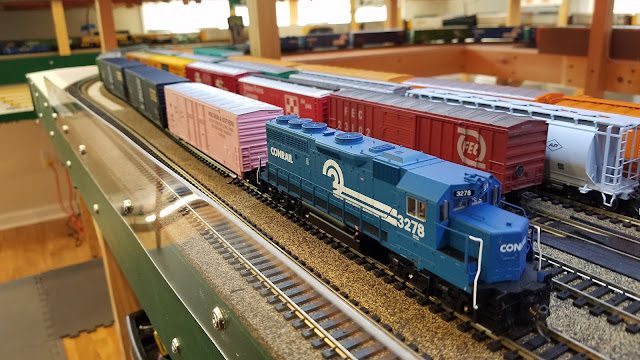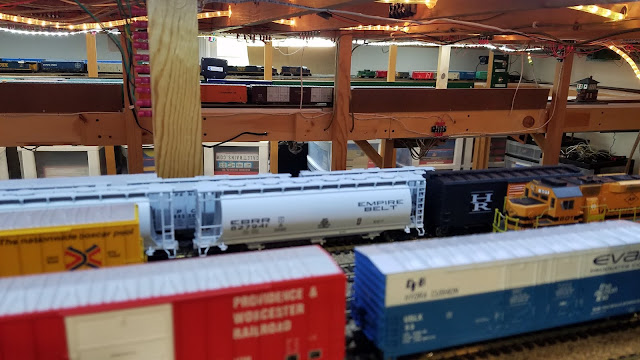Greetings followers of the Atlantic Pacific Railroad and my
blog!
As many of you know, I participate in both virtual op
sessions as well as live operating sessions at my home. The virtual op sessions
are very enjoyable when I’m not hosting. However, when I do host, all of the
railroad is in action, meaning that PC, AP, EB and any other virtual op cars
are in action.
When a virtual op session is being planned, the guys in both
Georgia and Minnesota, who invited me to join their virtual op sessions, set up
the moves and send out the dispatch sheet for us to follow. It shows where the
car was on the last move. In addition, an email comes out with a list of the
freight cars that are both outbound and inbound.
Herein lies the problem. When the sheet and email comes out,
it can take me hours to locate the cars if there’s been any type of train
movement on the layout. With approximately 400 freight cars on both levels, it
can take time to find them. They can be at an industry, freight yard, on an
existing freight train that was run, or on some stub staging tracks on the
lower level.
The solution – move as many of the virtual op session
freight cars to the lower level stub staging tracks, and the rest visible, as
in the freight yard. Don't get me wrong, many of the AP/EB/PC cars are used in my operating sessions when I host, so they are many in action. The lower level has 8 stub staging tracks beneath the freight yard; 4 on each side. Recently, I added 4 more on the lower level south staging east end.
Here is how the those tracks look once I moved many of the cars.
As you can see, there are many of the virtual op cars on these tracks. If for some reason I need them for one of my gatherings, I'll pull them out and send them to the yard or make up a train with them. This move took a couple hours as cars had to be taken off those tracks and moved elsewhere. This really makes it easy to look for the cars.
The next objective of this project was to lighten up the engine terminal. What does that mean? There were more than 40 engines down there, and most were there for show and had not been run in a while. It was choking the terminal. Another reason to lighten it up was to make room so I can start to add this entire area to my operating sessions as well as the possibility to my virtual op sessions in the future.
I left 2 of my CSX 6 axle engines down there. Both have sound and I may use them on my auto rack train. Currently, that train has a pair of SD40-2 engines on that train and I may want to change them out for some bigger engines. There was an SD90MAC sitting down there looking pretty, but never used, so that came off the layout. A total of 12 engines were put away. Now the entire area looks better and will give the person assigned to the engine terminal some breathing room. Here's how the entire area looks...
The next project involved freight trains. While both North and South staging held many trains, those were anywhere from 12-16 freight cars in length. With the exception of a few train sets, most were manifest trains / mixed freight. Below the main section of the layout (below the freight yard and Tropicana / Cargill) is a loop track which I had used for staging train sets. Unless I had them slated to run during an operating session, they rarely moved. NJ John came up with a suggestion that instead of having 2 large trains with a pair of engines on each train, to break them up into 4 smaller trains with 5-6 freight cars, an engine and caboose. I took him up on his suggestion, and here's what we now have...
These 4 'locals' can be sent to the yard or to a specific industry. I have one track on the west side that's empty, which gives me some breathing room below. More than likely I'll 'test' these trains when I host my special operating sessions with specific operators. Those operators don't mind using some type of train lists for a session. I tried it once, and it worked out well. I was short the yardmaster, so I did double duty. We had 3 guys using the cards I made up, and despite the small crew, it worked out well. The freight yard up top is now lighter so it can receive freight from those locals or manifest trains when I host.
I'm looking forward to my next virtual op session as well as being able to host a gathering. During these trying times, the guys without layouts are itching to run trains and the requests for me to send them videos of trains running (which I have done), help easy the withdrawal symptoms some of them are having.
Thanks for reading!


















Congratulations on getting the APRR organized for both virtual and actual ops. A juggling act for sure! On the NYCTL I have a fair sized box where many of the virtual ops cars end up when the leave the layout. A similar box with current Dispatch Sheet is being considered among other possibilities. As a layout owner with an engine terminal and more engines than needed😊 I try to rotate the power so every engine gets some run time. Good luck on your continued quest for virtual and actual ops compatibility!
ReplyDeleteWow! I had no idea how much rolling stock you have to manage! Sous like you've come up with some good plans for that and for your locomotives!
ReplyDelete